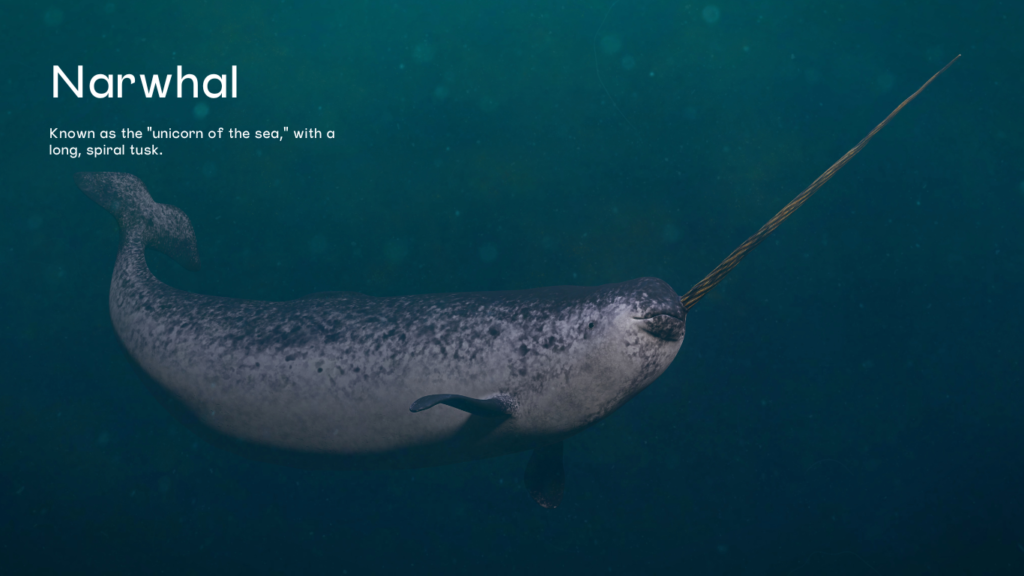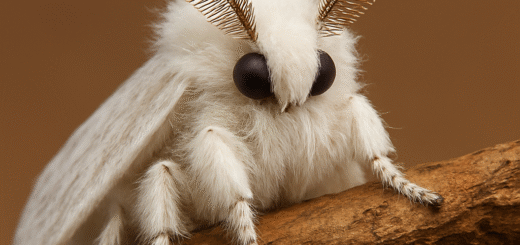Narwhals: The Mysterious “Unicorns of the Sea”
Narwhal (Monodon monoceros), often dubbed the “unicorn of the sea,” is one of the ocean’s most extraordinary and enigmatic creatures. Known for the long, spiral tusk that extends from its head, the narwhal has inspired myths, folklore, and scientific curiosity for centuries. This elusive whale is native to Arctic waters and has a fascinating biology, unique behavior, and a role in the fragile Arctic ecosystem. In this article, we will explore the narwhal’s physical characteristics, its iconic tusk, habitat, behavior, diet, and conservation status.

Physical Characteristics
Narwhals belong to the family Monodontidae, which includes only one other species—the beluga whale. Narwhals are medium-sized whales, with males typically reaching lengths of 13-18 feet (4-5.5 meters) and females slightly smaller at 11-14 feet (3.5-4.5 meters). Males weigh between 1,760-3,500 pounds (800-1,600 kg), while females are generally lighter.
A narwhal’s body is distinctively streamlined, adapted for life in icy waters. It is covered in a thick layer of blubber to insulate against the freezing Arctic temperatures. Narwhals are typically gray with a mottled pattern of black and white that serves as camouflage, allowing them to blend into their icy surroundings and avoid predators like orcas and polar bears.
Read to The Blobfish: An Unexpected Icon of the Deep Sea
The Legendary Tusk
The most distinguishing feature of the narwhal is, of course, its long tusk, which can reach lengths of 7-10 feet (2-3 meters) in males. This tusk is actually an elongated, spiralized left canine tooth that grows out of the upper jaw, twisting counterclockwise. The tusk has a dense, nerve-filled structure, with up to 10 million nerve endings running through it, making it a highly sensitive organ.
While it is rare, some females also develop tusks, though they are generally much shorter than those of males. In even rarer cases, some narwhals may grow two tusks if both canine teeth develop. For centuries, the narwhal’s tusk was the source of mythical tales, as explorers and traders brought tusks to Europe, where they were sold as unicorn horns with alleged magical properties.
Scientists have proposed several theories regarding the purpose of the narwhal tusk. Some believe it is used as a secondary sexual characteristic, much like antlers on a deer, where males with larger tusks may attract mates. Others suggest that the tusk may have sensory functions, helping the narwhal detect changes in its environment, such as water temperature, salinity, and pressure. Recent observations have shown narwhals using their tusks to “tap” or “slap” prey, indicating it may also serve a role in foraging.
Habitat and Distribution
Narwhals are native to the Arctic Ocean, particularly in the icy waters around Greenland, Canada, and Russia. They are primarily found in fjords and bays during the summer months and move into deeper offshore waters under heavy sea ice in the winter. Narwhals are highly adapted to life in the Arctic; they are among the few marine animals capable of thriving in environments with dense sea ice.
Due to their reliance on specific Arctic conditions, narwhals have one of the most restricted ranges of any marine mammal. They spend their lives migrating between coastal summer grounds and winter areas, typically traveling in groups, known as pods, of 10-20 individuals. In the winter, they can dive as deep as 1,500 meters (4,900 feet) in search of food, holding their breath for up to 25 minutes at a time.
Diet and Hunting
Narwhals have a relatively specialized diet, consisting primarily of Greenland halibut, Arctic and polar cod, shrimp, and squid. Unlike many other marine mammals, narwhals do not have well-developed teeth for chewing or tearing prey, leading scientists to believe they may use suction to capture and swallow their food whole. Narwhals often dive to great depths to access their prey, and their ability to dive so deeply makes them exceptional hunters in the challenging Arctic environment.
Narwhals typically hunt in winter, taking advantage of the lower availability of prey in summer to conserve energy. Their foraging dives can reach depths of nearly 1,800 meters (5,900 feet), one of the deepest diving records for any marine mammal.
Social Structure and Behavior
Narwhals are social animals, often forming pods with complex social structures. Pods are generally composed of males, females, and young calves, though male-only groups, known as bachelor pods, are also observed. During the summer, several pods may gather in large aggregations of hundreds, or even thousands, of narwhals.
Narwhals are vocal animals, communicating through clicks, whistles, and other sounds, which serve multiple purposes, such as navigation, social bonding, and hunting. These vocalizations are essential for echolocation—a skill that enables them to locate prey and navigate through the murky waters beneath the ice.
During the winter months, narwhals display an extraordinary tolerance to sea ice and can navigate areas with up to 97% ice coverage, surfacing to breathe through cracks or small openings in the ice. This remarkable behavior showcases their resilience and adaptation to one of the world’s most extreme environments.
Conservation Status and Threats
The narwhal population is estimated at around 80,000, and while it is not currently considered endangered, the species faces several pressing threats that could impact its survival. Climate change poses the most significant threat to narwhals. As temperatures rise, Arctic sea ice is melting at an alarming rate, disrupting the narwhal’s habitat and forcing the species into narrower and more isolated ranges.
The reduction in sea ice not only threatens the narwhal’s habitat but also attracts increased human activity, such as shipping, tourism, and oil and gas exploration. Increased human presence in the Arctic disrupts narwhal habitats, introduces noise pollution, and raises the risk of oil spills. Narwhals are highly sensitive to noise, and increased noise pollution from ships can interfere with their communication and echolocation, potentially leading to disorientation and increased predation.
The Inuit people of Greenland and Canada have a longstanding tradition of hunting narwhals for subsistence, relying on their meat, blubber, and tusks. This traditional hunt is sustainable and regulated, but increasing commercial interest in narwhal tusks has raised concerns about overhunting.
Conservation Efforts
Conserving narwhals requires a multifaceted approach that involves international cooperation, scientific research, and Indigenous knowledge. Arctic nations and conservation organizations are working to establish protected areas and to regulate hunting, while also reducing the impact of industrial activities in the region. Efforts to reduce greenhouse gas emissions and combat climate change are crucial, as a stable climate is essential to maintaining the Arctic sea ice habitat that narwhals and many other species rely on.
Furthermore, scientists are studying the effects of noise pollution on narwhals to develop guidelines that would limit ship traffic in critical narwhal habitats. Collaborating with Indigenous communities is also essential, as these communities have a wealth of traditional ecological knowledge that can enhance conservation efforts and provide a more comprehensive understanding of narwhal behavior and habitat needs.
Conclusion
The narwhal is a unique and enigmatic marine mammal that symbolizes the beauty and mystery of the Arctic. With its distinctive tusk, impressive diving abilities, and adaptations to the extreme conditions of its icy habitat, the narwhal remains a subject of fascination and scientific inquiry. However, like many Arctic species, it faces increasing challenges due to climate change and human activities.
Efforts to protect narwhals are not only about conserving a single species but also about preserving the fragile Arctic ecosystem that supports a rich diversity of life. By working together, the global community has a chance to ensure that the “unicorns of the sea” continue to thrive in the wild and enchant us with their mysterious beauty for generations to come.








